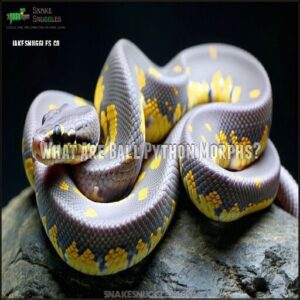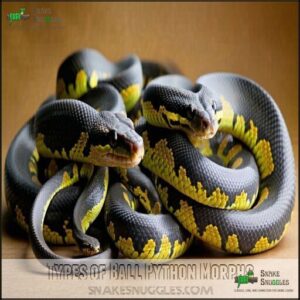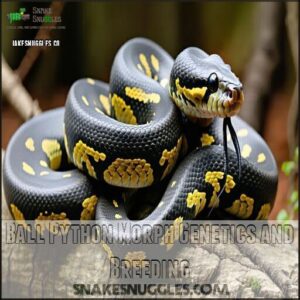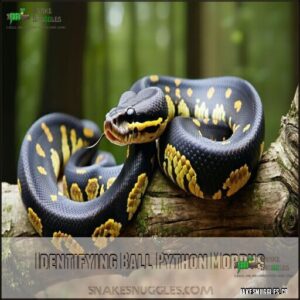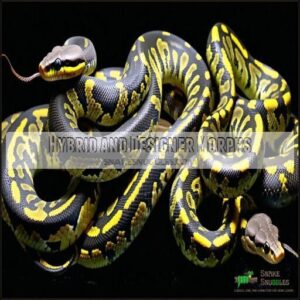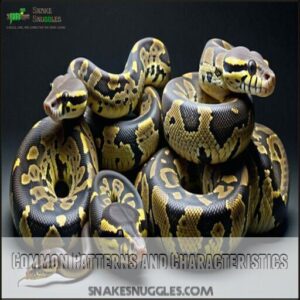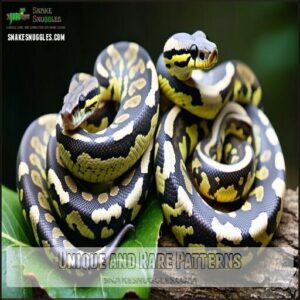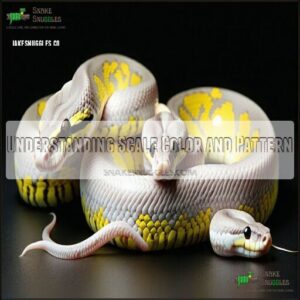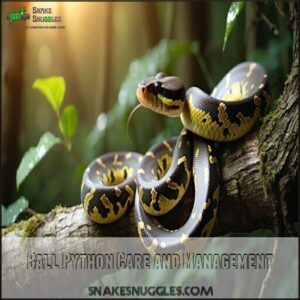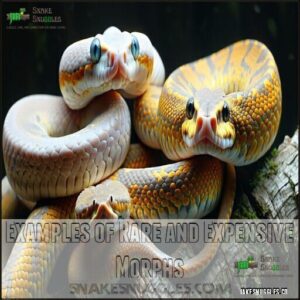This site is supported by our readers. We may earn a commission, at no cost to you, if you purchase through links.
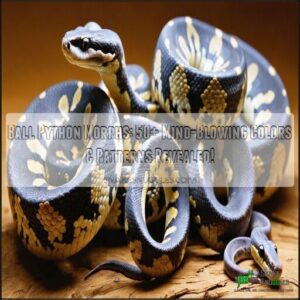
You’ll find morphs ranging from classic patterns to mind-blowing color combinations. Imagine snakes with stunning albino whites, deep lavender hues, or intricate geometric designs that look like nature’s own abstract painting.
Genetic variations create everything from solid-colored beauties to complex patterns that’ll make your jaw drop. Each morph tells a unique genetic story, with some traits being dominant, recessive, or co-dominant.
Whether you’re a reptile enthusiast or just love jaw-dropping biological diversity, ball python morphs are nature’s most spectacular genetic playground, offering a wide range of genetic marvels and biological diversity with living artworks.
Table Of Contents
- Key Takeaways
- What Are Ball Python Morphs
- Types of Ball Python Morphs
- Ball Python Morph Genetics and Breeding
- Identifying Ball Python Morphs
- Ball Python Morph Prices and Health
- Hybrid and Designer Morphs
- Ball Python Morph Appearance and Patterns
- Ball Python Care and Management
- Rare and Expensive Ball Python Morphs
- Frequently Asked Questions (FAQs)
- What are ball python morphs and colors?
- What is the difference between a ball python and a morph?
- How do you identify a ball python morph?
- What color Python morphs look like?
- What is a red ball python morph?
- How many types of ball python morphs are there?
- What is the rarest morph of ball python?
- What are the colors of morph pythons?
- What is the most desirable ball python morph?
- How many morphs of ball pythons are there?
- Conclusion
Key Takeaways
- You’ll discover that ball python morphs are genetic variations that transform these reptiles into living art, with colors and patterns ranging from pure white to vibrant oranges and complex patterns.
- You’ll uncover the complexity of genetic inheritance, with morph traits being recessive, co-dominant, or dominant, which determines how unique colors and patterns are passed between generations.
- You’ll learn that morph prices can vary dramatically, from affordable $50 varieties to rare designer morphs costing thousands of dollars, depending on genetic complexity and market demand.
- You’ll realize that breeding ball pythons isn’t just a hobby, but a sophisticated practice that involves strategic genetic selection, careful trait mapping, and understanding potential health considerations like the neurological "wobble" condition.
What Are Ball Python Morphs
You might think all ball pythons look the same, but morphs are genetic variations that transform these snakes into living art with mind-blowing colors and patterns.
Genetic magic turns ordinary pythons into living masterpieces of color and pattern, revealing nature’s breathtaking artistic potential.
From snow-white to sunset orange, each morph tells a unique genetic story that’ll make you see these incredible reptiles in a whole new light.
Definition of Ball Python Morphs
Ready to plunge into the mind-bending world of ball python morphs? These genetic marvels transform ordinary snakes into living canvases of color and pattern.
- Morph classification reveals the intricate genetic variance behind each stunning snake
- Color genetics play a pivotal role in creating breathtaking visual combinations
- Pattern formation determines the snake’s distinctive aesthetic appeal
Ball python morphs are nature’s ultimate art project. Breeders carefully select pythons with specific traits, combining genetic characteristics to produce offspring that showcase remarkable color contrasts. Through selective breeding, these reptiles become living masterpieces that tell unique genetic stories.
Unlike their wild counterparts, morphs represent the incredible diversity potential within a single species. Each snake becomes an affirmation of the power of genetic inheritance, turning what could be an ordinary reptile into a mesmerizing creature that captures the imagination of enthusiasts and collectors alike. This showcases the power of genetic inheritance and highlights the unique genetic stories these snakes tell, making them a true marvel of genetic variance.
Genetics of Ball Python Morphs
Ball python morphs are nature’s genetic masterpiece, where DNA becomes an artist’s palette. Those wild snake colors aren’t random—they’re carefully choreographed by genetic mutations passed through generations.
Some traits hide quietly, waiting for the right partner to reveal themselves, while others boldly announce their presence from the first generation.
| Inheritance Type | Gene Expression | Breeding Impact |
|---|---|---|
| Recessive | Hidden unless two copies | Requires specific parent combinations |
| Co-dominant | Partial expression | Creates intermediate color variations |
| Dominant | Immediate visibility | Easily passes trait to offspring |
| Polygenic | Multiple gene interactions | Complex color development |
The table outlines the different types of inheritance, including recessive, co-dominant, dominant, and polygenic, which determine how traits are expressed and passed on to offspring. Understanding these concepts is crucial for breeding impact and predicting the outcome of different genetic combinations.
Difference Between Morphs and Polymorphism
In the fascinating domain of snake genetics, morphs and polymorphism represent two sides of the same colorful coin.
When you explore ball python genetics, you’ll discover how genetic variations transform ordinary reptiles into living art.
- Uncover nature’s genetic diversity
- Explore unexpected color transformations
- Decode hereditary pattern mysteries
- Witness breeding’s magical potential
- Reveal evolutionary complexity
Morphs are specific genetic mutations creating unique color and pattern variations, while polymorphism describes the natural occurrence of these variations within a species.
Selective breeding turns these genetic blueprints into stunning visual displays, transforming each ball python into a one-of-a-kind masterpiece of color and inheritance. Understanding ball python genetics is essential to appreciating the complexity of these morphs and the role of genetic variations in their creation.
Types of Ball Python Morphs
If you’re fascinated by snakes, ball python morphs will blow your mind with their incredible genetic variations that transform these reptiles into living works of art.
You’ll discover a stunning world of colors and patterns ranging from affordable everyday varieties to rare, jaw-dropping designer morphs that can cost thousands of dollars, showcasing incredible genetic variations.
Common and Affordable Morphs
Want affordable ball python morphs that won’t break the bank?
Black Pastels and Lessers offer stunning color variations at budget-friendly prices.
These snakes prove you can own a beautiful python without emptying your wallet.
| Morph | Price Range | Color Profile | Popularity |
|---|---|---|---|
| Black Pastel | $50-$150 | Dark gray-black | High |
| Lesser | $75-$200 | Soft lavender | Moderate |
| Pastel | $50-$100 | Yellow-green | Very High |
| Fire | $75-$150 | Bright orange | High |
Unique and Striking Morphs
Craving snake eye candy? Unique ball python morphs transform reptile collecting into a genetic art gallery.
From phantom’s shadowy urban camo to clown morphs’ wild designs, these striking color variations showcase nature’s incredible creativity.
Genetic mutations paint each snake with extraordinary patterns—soft blue-eyed leucistic whites, tiger-striped elegance, and Russo Leucistic’s mesmerizing palette reveal the incredible diversity hidden within these fascinating reptiles, with incredible diversity being a hallmark of their appeal.
Rare and Unique Morphs
After marveling at striking morphs, snake enthusiasts get ready to meet the rarest genetic gems in the ball python world.
These living artworks showcase nature’s incredible diversity through mind-bending color genetics:
- Blue-Eyed Lucy: Ghostly white with electric azure eyes
- Scaleless: Smooth serpent design defying expectations
- Stormtrooper: Midnight-black genetic marvel
- Paradox: Impossible patterns challenging biological norms
Rare morphs represent more than just unique color variations—they’re genetic lottery tickets born from selective snake breeding.
Each unique ball python tells a story of recessive mutations and careful genetic selection, transforming these reptiles from ordinary creatures into walking masterpieces of color and pattern.
Your journey into morph identification starts here.
Ball Python Morph Genetics and Breeding
You’ll discover the fascinating world of ball python genetics, where selective breeding transforms these slithery serpents into living canvases of color and pattern.
Learn how breeders strategically mix recessive, co-dominant, and dominant genes to create stunning morphs that’ll make your jaw drop and your inner reptile enthusiast cheer.
Recessive, Co-Dominant, and Dominant Genes
How do ball python morphs inherit their unique traits? These serpents’ genetic coding reveals three key inheritance patterns: recessive, co-dominant, and dominant genes.
Recessive mutations hide unless both parents carry the gene, creating a genetic mystery. Co-dominant traits blend colors dramatically, painting each python uniquely.
Dominant genes boldly express themselves with just one copy, ensuring their visibility in gene pools. Through selective breeding, breeders discover fascinating trait inheritance strategies that transform these remarkable reptiles, showcasing unique traits.
Creating New Morphs Through Breeding
Genetic crossroads reveal the magic of ball python morph creation. Your breeding journey begins with strategic genetic combinations that transform ordinary serpents into living art.
Consider these key strategies for successful morph development:
- Master Punnett square predictions to understand potential offspring traits
- Select parent snakes with complementary genetic characteristics
- Utilize advanced genetic testing to track inheritance patterns
Selective breeding techniques let you experiment with color morphs, pushing the boundaries of what’s possible. Professional breeders know that patience and precision are your greatest tools in hybridization methods.
Each carefully planned pairing holds the potential to reveal extraordinary color combinations, turning your ball python breeding passion into a scientific art form that celebrates genetic diversity. Understanding genetic variation principles is vital for creating unique morph combinations.
Preserving Existing Morphs
The art of preserving ball python morphs demands strategic genetic stewardship.
As a breeder, you’re not just raising snakes—you’re protecting living genetic libraries.
Your mission involves:
- Thoroughly tracking lineage
- Preventing genetic bottlenecks
- Minimizing inbreeding risks
- Documenting unique traits
- Sharing exhaustive breeding knowledge
Through careful morph conservation and advanced genetic testing, you’ll safeguard rare ball python colors and patterns.
Your breeding strategies transform you from a simple snake enthusiast into a guardian of extraordinary serpentine diversity, ensuring the preservation of these unique species.
Identifying Ball Python Morphs
You’ll want to become a ball python morph detective, using keen observation skills to spot unique color patterns and genetic traits.
By understanding how pigmentation, scale design, and eye color reveal a python’s specific genetic makeup, you’ll discover the fascinating world of these mesmerizing serpentine beauties.
Looking at Overall Color and Pattern
When breeding ball python morphs becomes a science, identifying unique color variations transforms into an art form.
Sharp-eyed enthusiasts decode the genetic language written across each snake’s skin.
- Color spectrum ranges from creamy whites to midnight blacks
- Pattern intensity reveals intricate alien head or flame-like designs
- Scale shades expose hidden genetic expressions
- Texture variations signal rare mutations
- Unexpected hue blending hints at complex lineage
- Speckles and stripes tell individual genetic stories
Precise morph classification demands understanding how python color genetics paint stunning canvases.
Each scale whispers secrets of inheritance, turning casual observation into expert-level identification.
Your trained eye learns to recognize the subtle dance of pigments that make every ball python morph a living, breathing masterpiece of nature’s genetic artistry, where genetic language is key to understanding these unique creatures.
Examining Blushing and Eye Color
Explore the sphere of 7 eye-popping ball python morph characteristics.
Blushing patterns reveal genetic secrets, with iris variations telling complex stories.
Pastel pythons showcase mesmerizing green eyes, while pupil color and saturation transform each snake into a living masterpiece.
These color genetics reveal the hidden language of python morph expression, turning every snake into a unique work of art, with complex stories told through their appearance.
Understanding Morph Rarity and Popularity
Peek into the fascinating world of ball python morph rarity, where market demand turns these slithery beauties into living art.
Morph popularity shifts like desert sands, with unique ball python colors commanding jaw-dropping prices.
Breeding costs, genetic complexity, and collector trends drive market fluctuations, making the study of genetic variations crucial.
Some rare morphs can fetch thousands, while others plummet in value, highlighting the importance of understanding these rarity factors in serpentine economics.
Understanding these factors isn’t just science—it’s an adventure that’ll make any reptile enthusiast’s wallet tremble, as it plays a pivotal role in determining the value and uniqueness of each ball python morph.
Ball Python Morph Prices and Health
When you’re exploring ball python morphs, you’ll quickly discover that their mesmerizing colors and patterns come with complex price tags and potential health considerations.
Understanding these factors will help you make an informed decision about which unique python companion might be the perfect addition to your reptile collection, considering the complex price tags.
Factors Affecting Ball Python Prices
Want to understand what makes a ball python morph a wallet-buster? The market’s wild ride depends on several key factors:
- Breeder reputation can skyrocket prices
- Unique color variations drive collector frenzy
- Genetic complexity determines snake value
- Rare morphs command premium pricing
From affordable $10 wild types to jaw-dropping $40,000 designer snakes, ball python morph pricing is a roller coaster of supply, demand, and pure genetic magic.
The Wobble Neurological Condition
Within the sphere of ball python morphs, the Wobble neurological condition emerges as a challenging genetic quirk that affects some snake varieties.
These neurological symptoms can disrupt a python’s motor skills, causing unpredictable head tremors and movement difficulties.
| Symptom | Impact | Management |
|---|---|---|
| Head Tremors | Motor Coordination | Minimize Stress |
| Uneven Movement | Daily Functioning | Stable Environment |
| Genetic Vulnerability | Health Risks | Compassionate Care |
The table outlines the symptoms, impact, and management of the neurological condition, providing a clear overview of the challenges and necessary care for affected snakes.
Morphs Prone to The Wobble
If you’re breeding ball python morphs, watch out for neurological landmines.
Some genetic lines are more prone to wobble symptoms than others.
Check these troublesome morphs:
- Spider morphs with signature tremors
- Champagne’s balance disruptions
- Woma’s coordination challenges
- Bumblebee’s neurological variations
- Powerballs’ stability struggles
Understanding these genetic quirks helps you manage breeding risks and snake health more effectively.
Hybrid and Designer Morphs
You’re about to discover the fascinating world of hybrid and designer ball python morphs, where breeders harness their creativity by combining unique genetic traits.
These extraordinary snakes result from carefully planned breeding strategies, producing mesmerizing color combinations that push the boundaries of natural variation and showcase the incredible genetic potential of these remarkable reptiles, with remarkable outcomes that are truly fascinating.
Creating New Morphs Through Hybridization
Genetic crosses reveal the mesmerizing world of ball python morphs, where hybrid breeding transforms snakes into living art.
By carefully selecting compatible genes, breeders orchestrate stunning color transformations that push the boundaries of python genetics.
The magic happens through precise breeding techniques that map out potential gene expressions.
| Technique | Impact |
|---|---|
| Gene Pairing | Color Variation |
| Selective Mating | Pattern Complexity |
| Recessive Trait Matching | Unique Morphs |
| Dominant Gene Selection | Predictable Outcomes |
| Hybridization Strategy | Morph Innovation |
This process allows for the creation of unique morphs and enables breeders to predict predictable outcomes through careful selection and hybridization strategy.
Examples of Hybrid Morphs
The enchantment of hybrid ball python morphs reveals nature’s genetic artistry through strategic crossbreeding.
When skilled breeders blend unique genetic traits, extraordinary serpentine masterpieces emerge.
- Bumblebee morphs dazzle with spider and pastel genetics, creating vibrant yellow and black patterns
- Candino combines lavender and albino traits for mesmerizing color variations
- Highway morphs blend gravel and yellow belly genes into stunning visual displays
- Lemon Blast showcases pinstripe and pastel collaborations with intricate, citrusy hues
These remarkable python morph combinations transform ordinary snakes into living canvases. Each hybrid breeding represents a delicate dance of genetic potential, where color patterns become an art form.
Enthusiasts and collectors prize these designer morphs not just for their aesthetic appeal, but as evidence of the incredible complexity of genetic crossing.
Characteristics of Designer Morphs
You’re entering the wild world of designer ball python morphs—where snake breeding meets artistic expression.
These incredible reptiles showcase jaw-dropping color genetics through strategic hybridization techniques. Imagine morphs like the mesmerizing Dreamsicle, blending creamy orange tones with intricate scale variations that make collectors’ hearts race.
Designer morphs aren’t just snakes; they’re living canvases where python morph genetics create breathtaking patterns impossible in nature. Breeders carefully select parent snakes to reveal extraordinary designer traits, pushing ball python color variations beyond imagination.
Each unique combination tells a genetic story, transforming these slithery companions into walking—or rather, sliding—masterpieces that challenge everything you thought you knew about snake aesthetics.
Ball Python Morph Appearance and Patterns
When you’re exploring ball python morphs, you’ll discover a mesmerizing world of genetic variations that transform these reptiles into living works of art.
From vibrant yellows and deep purples to intricate patterns that look like nature’s own abstract paintings, you’ll be amazed at how a single genetic mutation can create such stunning visual diversity.
Common Patterns and Characteristics
Ever wondered how ball python morphs create such stunning visual diversity?
Let’s unpack their enchanting patterns!
- Pattern Types range from subtle swirls to dramatic stripes
- Color Scales shift between rich earth tones and vibrant hues
- Morph Markings showcase unique "alien head" designs
- Scale Textures reveal intricate genetic storytelling
- Blotch Shapes transform each snake into a living canvas
Ball python patterns are nature’s artistry in motion, where each scale tells a unique genetic story of color, contrast, and complexity.
Unique and Rare Patterns
If you’ve marveled at typical snake patterns, prepare to have your mind blown by the extraordinary world of rare ball python morphs.
These living canvases showcase nature’s artistic genius through incredible Pattern Genetics and Color Mutations that defy imagination.
Imagine snake patterns that look like:
- Piebald patches interrupting classic designs like an unfinished masterpiece
- Paradox morphs splashing unexpected colors across smooth scales
- Highway patterns running like bold roadways down serpentine backs
- Scaleless snakes with skin so unique, it challenges everything you know about reptile texture
These Rare Markings transform ball python morphs from mere animals into living art. Each snake becomes a reflection of the incredible diversity hidden within genetic code, revealing how small mutations can create breathtaking variations in the snake world.
Understanding Scale Color and Pattern
Have you ever wondered what makes ball python morphs so visually stunning?
The intricate world of scale variations and pattern genetics reveals a genetic tapestry far more complex than meets the eye.
Color morphs transform skin pigmentation through remarkable mutations, creating mesmerizing textures and patterns.
Understanding the ball python morph guide is essential to appreciating these unique snakes.
| Morph Type | Color Variation | Pattern Complexity |
|---|---|---|
| Albino | Pale/White | Simple |
| Axanthic | Black/White | Intricate |
| Pastel | Soft Yellow | Moderate |
Each python’s unique design tells a fascinating genetic story.
Ball Python Care and Management
You’ll need more than a stunning morph to keep your ball python thriving; proper care demands precise environmental control, consistent nutrition, and dedicated maintenance.
Whether you’re a first-time snake owner or an experienced reptile enthusiast, understanding the nuanced requirements of these fascinating creatures will guarantee your scaly companion remains healthy, vibrant, and engaging, with proper care being essential to their well-being.
Providing Proper Environment and Nutrition
While creating a thriving ball python habitat might seem challenging, it’s easier than you think.
Your python’s well-being depends on precise environmental conditions that mimic their natural ecosystem.
Here’s how to nail python pet ownership:
- Maintain a temperature gradient of 88-92°F on the warm side and 75-85°F on the cool side
- Control humidity between 50-60% using hygrometers and misting
- Choose safe substrate like coconut husk for comfort and cleanliness
Feed pre-killed mice every 1-2 weeks, ensuring proper nutrition and minimal stress for your scaly companion.
Providing the right Ball Python Food is vital for their health and growth.
Handling and Maintenance Tips
Handling ball pythons requires a gentle touch and strategic approach. When managing your scaly companion, prioritize calm, short interactions that minimize stress.
Use clean hands and a supportive grip, supporting their entire body during handling. Maintain consistent humidity around 50-60% and guarantee terrarium temperatures between 75-85°F for ideal ball python care.
Watch for subtle stress signals like defensive posturing or frequent hiding. Limit handling sessions to 10-15 minutes, allowing your python to feel secure while gradually building trust through predictable, respectful interactions.
Proper Ball Python Enclosures design is vital for creating a healthy environment.
Health Issues and Solutions
After mastering handling techniques, safeguarding your ball python’s health becomes your next mission.
Navigate potential challenges by implementing strategic care protocols:
- Disease Prevention: Research morph-related genetic predispositions before selecting your snake.
- Veterinary Care: Schedule routine check-ups to detect neurological conditions like wobble early.
- Snake Nutrition: Provide balanced diets supporting robust immune system function.
- Environmental Management: Maintain pristine enclosures to minimize health risks.
Ball python health isn’t rocket science—it’s about understanding your snake’s unique genetic blueprint.
Some morphs carry higher risks of neurological conditions, so knowledge is your best defense.
By staying proactive and attentive, you’ll help your scaly companion thrive, turning potential health hurdles into manageable speed bumps on your reptile care journey.
Proper snake care also involves understanding the importance of adequate Ball Python Food options to promote overall health.
Rare and Expensive Ball Python Morphs
Nature’s most stunning ball python morphs are living art—genetic masterpieces that transform ordinary reptiles into extraordinary serpentine canvases.
If you’re a snake enthusiast looking to own a truly exceptional ball python, you’ll want to explore the sphere of rare and expensive morphs that can cost thousands of dollars.
These unique genetic variations showcase stunning colors and patterns that’ll make your reptile collection the envy of every snake lover, with some morphs fetching prices as high as $70,000 for a single snake.
Examples of Rare and Expensive Morphs
After mastering ball python care, you’re ready to explore the sphere of rare morphs that turn heads and drain wallets.
Rare ball python morphs: Where genetic artistry meets wallet-draining magnificence!
These genetic marvels aren’t just pets—they’re living art pieces that collectors crave.
| Morph | Unique Feature | Price Range |
|---|---|---|
| Sunset | Fiery orange base | $5,000-$10,000 |
| Blue-Eyed Leucistic | Pure white, crystal blue eyes | $3,000-$5,000 |
| Scaleless | Smooth, scale-free skin | $2,500-$4,000 |
| Dreamsicle | Pastel orange/white blend | $3,500-$7,000 |
Rare ball python morphs showcase nature’s incredible genetic diversity, transforming these reptiles into living masterpieces.
Factors Affecting Rarity and Price
After discovering jaw-dropping rare morphs, you’ll want to understand what actually drives their mind-blowing prices. Ball python morph rarity isn’t random—it’s a complex dance of genetics, market trends, and breeding challenges.
Factors like color uniqueness, genetic complexity, and breeder reputation can skyrocket prices faster than you’d imagine.
- Price isn’t just a number—it’s a story of genetic magic
- Some morphs are rarer than a unicorn’s selfie
- Breeding costs can turn snake genetics into a high-stakes poker game
- Market demand shifts like desert sand
- Your dream morph might cost more than your monthly rent
Investment Potential of Rare Morphs
In the ever-shifting python morph market, investing in rare ball pythons is like traversing a thrilling financial ecosystem.
- Track morph market trends for strategic insights
- Partner with ethical breeders producing unique morphs
- Diversify your collection to manage investment risks
- Understand how rarity drives ball python morph value
Smart investors know that ball python morph prices fluctuate based on breeding costs, genetic complexity, and market demand. By staying informed about rare breeds and emerging patterns, you’ll be positioned to make calculated decisions in this fascinating investment landscape.
Frequently Asked Questions (FAQs)
What are ball python morphs and colors?
Ball python morphs are genetic variations producing unique colors and patterns.
You’ll find them ranging from pure white to vibrant oranges, with prices varying from $300 to thousands based on rarity and breeding complexity.
What is the difference between a ball python and a morph?
Wild and captive pythons might look similar, but morphs are genetically unique.
You’ll find a standard ball python is nature’s original design, while morphs are selectively bred variations with distinct colors, patterns, and inherited traits.
How do you identify a ball python morph?
You’ll identify a ball python morph by examining its unique color patterns, genetic markings, and distinctive traits.
Precise visual cues and expert knowledge help distinguish specific morphs from standard ball pythons, which is a complete concept that requires careful consideration.
What color Python morphs look like?
You’ll discover mesmerizing python colors ranging from pure white to vibrant orange, lavender, and yellow.
Each morph offers unique patterns like alien heads, spiderweb markings, and creamy blotches that’ll captivate your imagination.
What is a red ball python morph?
You’ll find the red ball python morph striking with its deep crimson or reddish-orange hues.
Rare and sought-after, these snakes showcase stunning genetic variations that transform their traditional coloration into vibrant, eye-catching patterns, with stunning genetic variations and vibrant displays.
How many types of ball python morphs are there?
You’ll be amazed to know there are over 10,000 ball python morphs.
Breeders have created an incredible variety through selective genetic breeding, transforming these snakes from basic patterns to stunning, unique color combinations.
What is the rarest morph of ball python?
Like a rare gem hidden in a treasure chest, the Blue-Eyed Leucistic (BEL) ball python stands out as the rarest morph.
You’ll rarely find this pinkish-white beauty with stunning dark blue eyes, making it a prized collector’s dream.
What are the colors of morph pythons?
You’ll encounter ball python morphs in a stunning rainbow of colors: pure white, vibrant yellow, soft lavender, rich orange, deep purple, and silvery black.
Each genetic variation paints a unique, mesmerizing pattern on these enchanting serpents, showcasing complete concepts of color and pattern variation, with stunning visual effects.
What is the most desirable ball python morph?
Like a rare gem in a treasure trove, the Blue-Eyed Leucistic (BEL) morph reigns supreme.
You’ll pay top dollar for its pristine white scales and mesmerizing dark blue eyes, making it the most coveted ball python in the exotic pet world.
How many morphs of ball pythons are there?
You’ll be amazed that over 7,000 ball python morphs currently exist, ranging from common varieties to ultra-rare designer breeds.
Breeders continually develop new combinations, pushing the boundaries of genetic possibilities with each generation.
Conclusion
Ultimately, nature’s brush paints ball python morphs with genetic brilliance.
You’ll discover a world where ball python morphs and colors transform ordinary reptiles into living masterpieces.
From affordable classics to rare designer variants, these snakes showcase stunning genetic diversity.
Whether you’re a hobbyist or serious breeder, understanding morph genetics opens fascinating windows into biological complexity.
Enter this mesmerizing domain and let your curiosity slither through the incredible landscape of ball python diversity, where you can explore the biological complexity.

